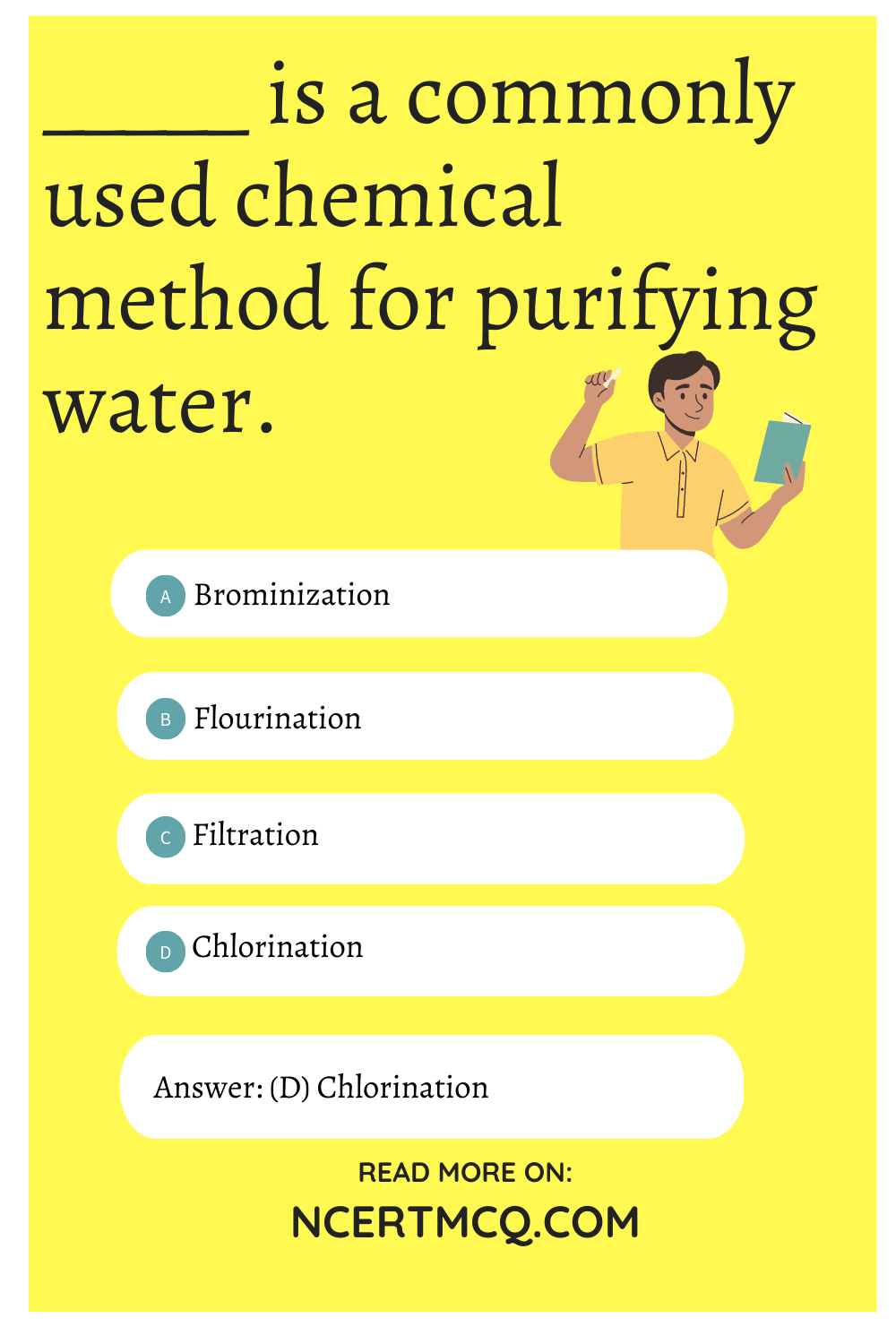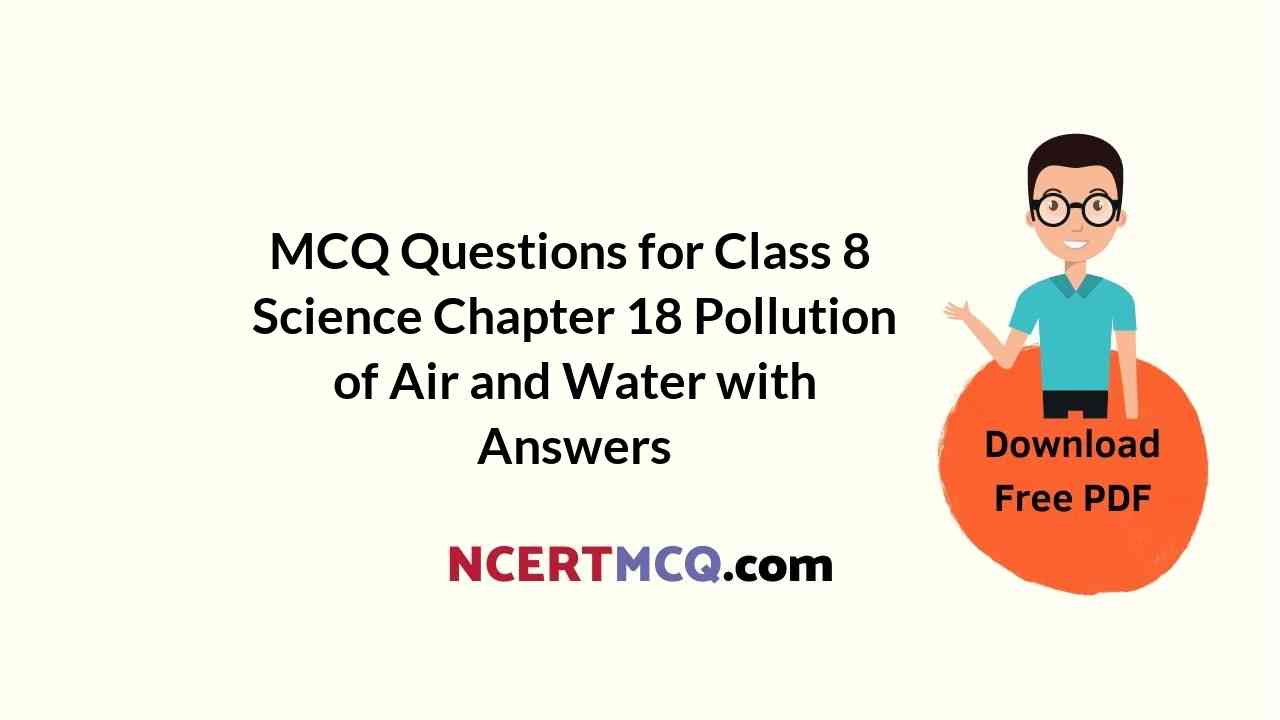Check the below Online Education NCERT MCQ Questions for Class 8 Science Chapter 18 Pollution of Air and Water with Answers Pdf free download. MCQ Questions for Class 8 Science with Answers were prepared based on the latest exam pattern. We have provided Pollution of Air and Water Class 8 Science MCQs Questions with Answers to help students understand the concept very well. https://ncertmcq.com/mcq-questions-for-class-8-science-with-answers/
You can refer to NCERT Solutions for Class 8 Science Chapter 18 Pollution of Air and Water to revise the concepts in the syllabus effectively and improve your chances of securing high marks in your board exams.
Class 8 Science Chapter 18 MCQ With Answers
Science Class 8 Chapter 18 MCQs On Pollution of Air and Water
Choose the correct option in the following questions:
Pollution Of Air And Water Class 8 MCQ Question 1.
Which gas is the major pollutant of air?
(a) Carbon monoxide
(b) Nitrogen
(c) Oxygen
(d) Propane
Answer
Answer: (a) Carbon monoxide
Class 8 Science Chapter 18 MCQ Question 2.
The increase in concentration of which gas is not responsible for Global Warming?
(a) Sulphur dioxide
(b) Nitrogen
(c) Carbon dioxide
(d) Methane
Answer
Answer: (b) Nitrogen
Class 8 Science Ch 18 MCQ Question 3.
In which year Ganga Action Plan was launched?
(a) 1980
(b) 1984
(c) 1982
(d) 1985
Answer
Answer: (d) 1985

MCQ On Pollution Of Air And Water Class 8 Question 4.
What radiations are absorbed by CO2?
(a) Ultrared radiations
(b) Infrared radiations
(c) Ultraviolet radiations
(d) None of these
Answer
Answer: (b) Infrared radiations
Class 8 Pollution Of Air And Water MCQ Question 5.
Which element is present in the exhaust of automobiles?
(a) Lead
(b) Calcium
(c) Chromium
(d) Magnesium
Answer
Answer: (a) Lead
Pollution Of Air And Water MCQ Question 6.
The phenomenon of marble cancer is due to
(a) soil particles
(b) fog
(c) CFCs
(d) acid rain
Answer
Answer: (d) acid rain
MCQ Questions For Class 8 Science With Answers Pollution Of Air And Water Question 7.
The solid or liquid particles dispersed in the air are called
(a) oxides
(b) acids
(c) hydrocarbons
(d) aerosols
Answer
Answer: (d) aerosols
Class 8 Science Pollution Of Air And Water MCQ Question 8.
The type of pollution which is likely to affect Taj Mahal in Agra to a greater extent is
(a) air pollution
(b) soil pollution
(c) water pollution
(d) noise pollution
Answer
Answer: (a) air pollution
Pollution Of Air And Water Class 8 MCQs Question 9.
The major causes of air pollution include
(a) burning of coal and petroleum
(b) afforestation
(c) deforestation
(d) recycling of paper
Answer
Answer: (a) burning of coal and petroleum
Ch 18 Science Class 8 MCQ Question 10.
Bhopal tragedy was caused due to
(a) air pollution
(b) emission of poisonous gas
(c) water pollution
(d) leakage of poisonous gas
Answer
Answer: (d) leakage of poisonous gas
MCQ On Pollution Of Air And Water Pdf Question 11.
Which of the following contents is most harmful to aquatic animals?
(a) Heavy metal ions
(b) Sodium ions
(c) Potassium ions
(d) Chloride ions
Answer
Answer: (a) Heavy metal ions
MCQ Of Pollution Of Air And Water Class 8 Question 12.
Water containing high salt concentration can be purified by
(a) boiling
(b) UV irradiation
(c) filtration
(d) reverse osmosis
Answer
Answer: (d) reverse osmosis
Pollution Of Air Class 8 MCQ Question 13.
Which of the following is a non-biodegradable pollutant?
(a) Sulphur dioxide
(b) DDT
(c) Nitrogen oxide
(d) Hydrogen oxide
Answer
Answer: (b) DDT
Air And Water Pollution Class 8 MCQ Question 14.
Which of the following is major source of water pollution?
(a) Industrial wastes
(b) Untreated sewage
(c) Use of fertilisers
(d) Toxic metals
Answer
Answer: (b) Untreated sewage
MCQs On Pollution Of Air And Water Question 15.
Which of the following techniques of irrigation should be used to save water?
(a) Water wheel
(b) Canal irrigation
(c) Drip irrigation
(d) Lift irrigation
Answer
Answer: (c) Drip irrigation
Question 16.
Carbon monoxide in vehicle exhaust causes
(a) Increased oxygen carrying capacity of RBCs
(b) Reduced Nitrogen carrying capacity of RBCs
(c) Reduced oxygen carrying capacity of RBCs
(d) Reduced carbon carrying capacity of RBCs
Answer
Answer: (c) Reduced oxygen carrying capacity of RBCs
Question 17.
Smog =
(a) Smoke in dog’s stomach
(b) Smoke + fog
(c) Smoke dog
(d) frog in fog
Answer
Answer: (b) Smoke + fog
Question 18.
The gas used in refrigerating appliance causing serious damage to ozone is
(a) MFCs
(b) CFCs
(c) LPCs
(d) DPCs
Answer
Answer: (b) CFCs
Question 19.
Acid rain mainly contains
(a) Sodium chloride
(b) Sulphur dioxide and Nitrogen dioxide
(c) Hydrochloric acid
(d) Carbon tetra chloride
Answer
Answer: (b) Sulphur dioxide and Nitrogen dioxide
Question 20.
Marble cancer is caused by
(a) bacteria
(b) virus
(c) Acid rain
(d) Alkali rain
Answer
Answer: (c) Acid rain
Question 21.
Greenhouse effect is
(a) Painting house green in colour
(b) Wearing green colour dress
(c) Having green room in the house
(d) Sun’s heat is trapped and not allowed to escape
Answer
Answer: (d) Sun’s heat is trapped and not allowed to escape
Question 22.
Greenhouse gases includes
(a) CO2, Methane, Nitrous oxide
(b) CO2, Argon, Nitrous oxide
(c) CO2, Methane, Chlorine
(d) CO2, Methane, Flourine
Answer
Answer: (a) CO2, Methane, Nitrous oxide
Question 23.
_____ is a commonly used chemical method for purifying water.
(a) Brominization
(b) Flourination
(c) Filtration
(d) Chlorination
Answer
Answer: (d) Chlorination

Question 24.
Ganga Action Plan is associated with
(a) Increase of fish culture in the Ganges
(b) Reduce Ganga water pollution
(c) Construct more bridges over the Ganges
(d) Increase water transport on the Ganges
Answer
Answer: (b) Reduce Ganga water pollution
Question 25.
Van Mahotsav is
(a) Planting trees in January
(b) Cutting trees in January
(c) Cutting trees in July
(d) Planting trees in July
Answer
Answer: (d) Planting trees in July
Match the following items given in Column ‘A’ with that in Column ‘B’:
| Column A | Column B |
| (i) Greenhouse gas | (a) Absorbed by CO2 |
| (ii) Infrared radiations | (b) Polluting gas |
| (iii) Oxides which affect vegetation | (c) Fog |
| (iv) Sulphur dioxide | (d) Caused by smog |
| (v) Condensed wider vapour in air | (e) Smoke + fog + fumes |
| (vi) Asthma | (f) Carbon dioxide |
| (vii) Smog | (g) Nitrogen oxides |
Answer
Answer:
| Column A | Column B |
| (i) Greenhouse gas | (f) Carbon dioxide |
| (ii) Infrared radiations | (a) Absorbed by CO2 |
| (iii) Oxides which affect vegetation | (g) Nitrogen oxides |
| (iv) Sulphur dioxide | (b) Polluting gas |
| (v) Condensed wider vapour in air | (c) Fog |
| (vi) Asthma | (d) Caused by smog |
| (vii) Smog | (e) Smoke + fog + fumes |
Fill in the blanks with the appropriate words:
1. Air contains the highest percentage of …………..
Answer
Answer: nitrogen
2. Most of the atmospheric air is contained in the atmospheric layer called …………..
Answer
Answer: troposphere
3. Stratosphere layer of the atmosphere protects us from …………..
Answer
Answer: ultraviolet radiations
4. An odd combination of smoke and fog is called ……………
Answer
Answer: smog
5. The solid or liquid particles dispersed in air are called ……………
Answer
Answer: aerosols
State whether the statements given below are True or False:
1. Carbon monoxide is a poisonous gas.
Answer
Answer: True
2. CFCs are not used in air conditioners.
Answer
Answer: False
3. Infrared radiations are absorbed by oxygen.
Answer
Answer: False
4. Ultra violets radiations are absorbed by ozone.
Answer
Answer: True
5. SO2, CO2and Nitrogen oxides are polluting gases.
Answer
Answer: True
We hope the given NCERT MCQ Questions for Class 8 Science Chapter 18 Pollution of Air and Water with Answers Pdf free download will help you. If you have any queries regarding Pollution of Air and Water CBSE Class 8 Science MCQs Multiple Choice Questions with Answers, drop a comment below and we will get back to you soon.
Class 8 Science MCQ:
- Crop Production and Management Class 8 MCQ
- Microorganisms: Friend and Foe Class 8 MCQ
- Synthetic Fibres and Plastics Class 8 MCQ
- Materials: Metals and Non-Metals Class 8 MCQ
- Coal and Petroleum Class 8 MCQ
- Combustion and Flame Class 8 MCQ
- Conservation of Plants and Animals Class 8 MCQ
- Cell Structure and Functions Class 8 MCQ
- Reproduction in Animals Class 8 MCQ
- Reaching the Age of Adolescence Class 8 MCQ
- Force and Pressure Class 8 MCQ
- Friction Class 8 MCQ
- Sound Class 8 MCQ
- Chemical Effects of Electric Current Class 8 MCQ
- Some Natural Phenomena Class 8 MCQ
- Light Class 8 MCQ
- Stars and the Solar System Class 8 MCQ
- Pollution of Air and Water Class 8 MCQ
